Banks – Chart Update
The following charts show the correlation of the US bank price performance versus leading ASX banks.
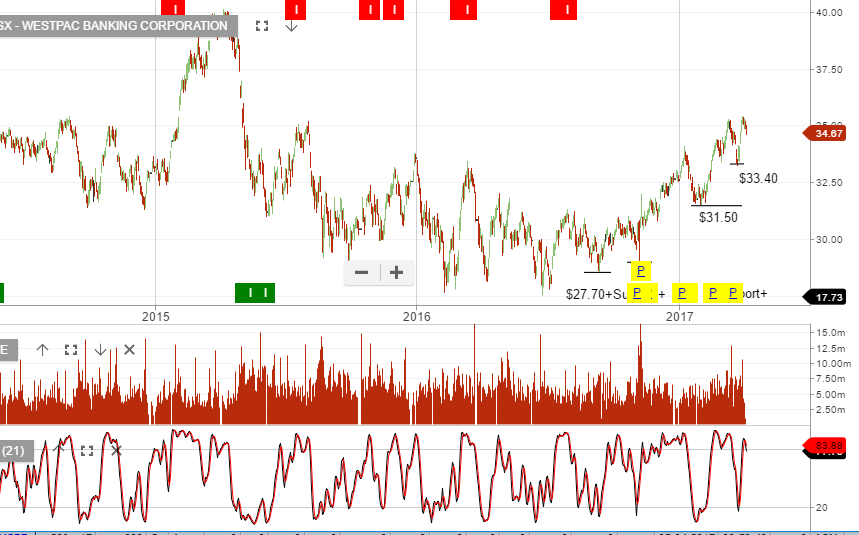

The following charts show the correlation of the US bank price performance versus leading ASX banks.


The Dow Jones has found short-term support in the higher low structure at 20,412. A break below this in the next day or two will be negative for US equities.
For the time being, we’re seeing buy signals from the Algo Engine in some of the beaten-down key US financials, Goldman Sachs, JP Morgan, Morgan Stanley & and Bank of America.
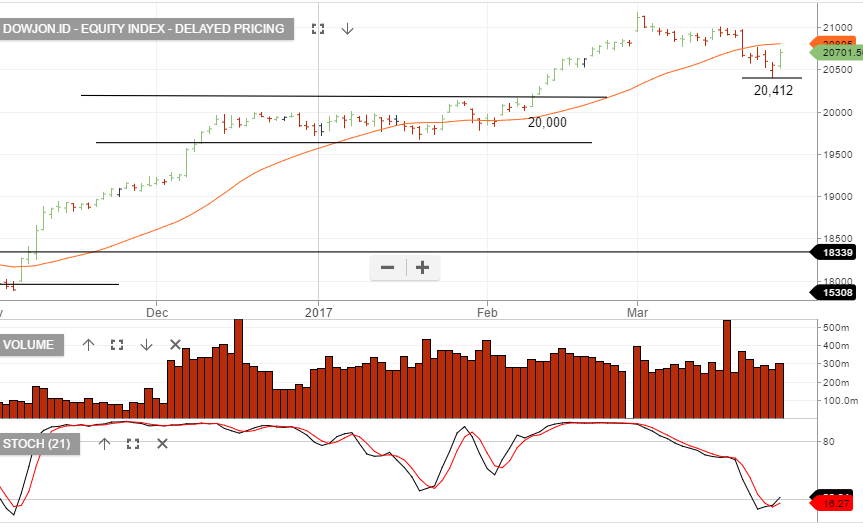


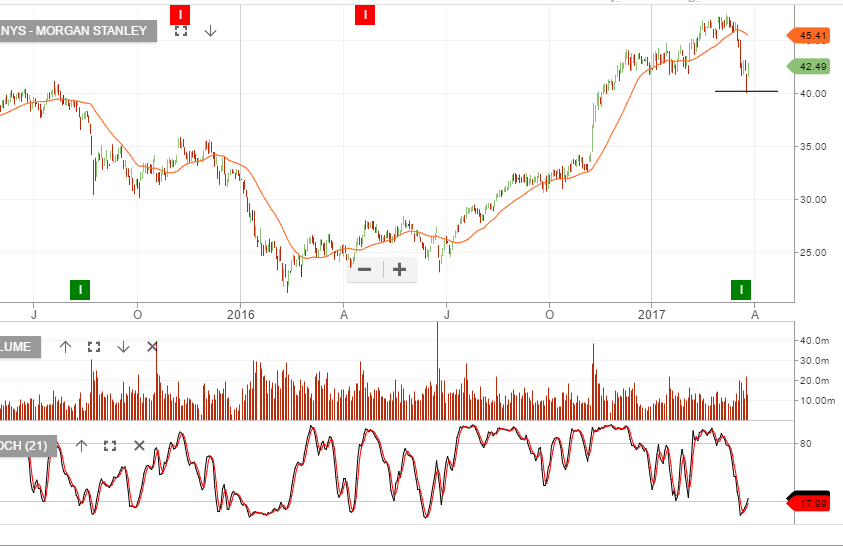

US Stock Indexes finished the week mixed as many investors were focused on how the House of Representatives would vote on the administration’s bill to repeal major parts of the current health care program, referred to as Obamacare.
As the day progressed, the DOW and SP 500 swung between positive and negative territory as news reports gave conflicting stories about whether the bill would pass, or even be voted upon.
In the end, after Mr Trump’s ultimatum failed to yield more “yes” votes , the embattled bill seeking to start the healthcare reform process, and free up almost a trillion dollars in tax dollars, was pulled from the floor.
As a result, Mr Trump suffered a second consecutive blow from within his own Republican party. This party dissension will likely cast doubts on the President’s ability to deliver on other policy measures including; tax reform, infrastructure spending and the debt ceiling legislation.
The announcement that the vote was cancelled happened too late in the day to have any material impact on today’s trade.
However, going into next week, investors will have to address the question of how Mr Trump can now unify his own party behind his administration; and whether this legislative defeat will “deflate” the “reflation” trade, which was triggered after he was elected?
With the recent sell-off in US equities, we’re now seeing a number of Algo long signals appear in the US financial names.
We’re mindful of the “peak optimism” that is priced in regarding tax cuts, deregulation & US economic pickup and approach these buy signals with caution.
We’ll be tracking the short term momentum indicators in Goldman Sachs and Bank of America as a leading indicator to market sentiment.
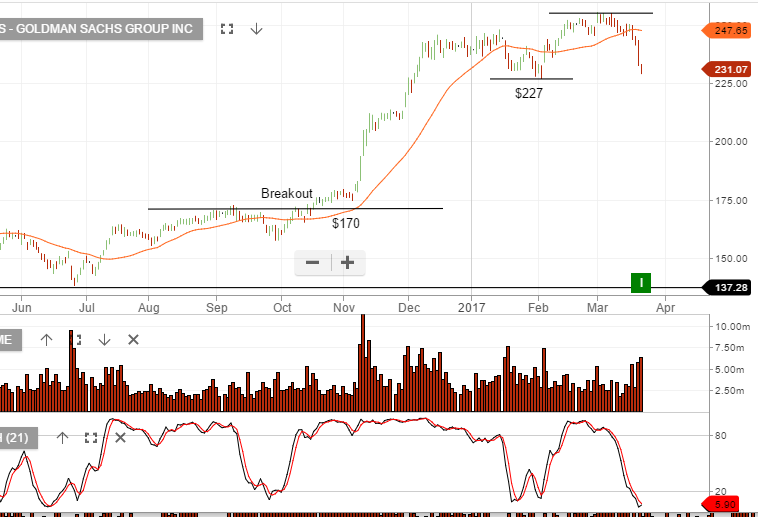
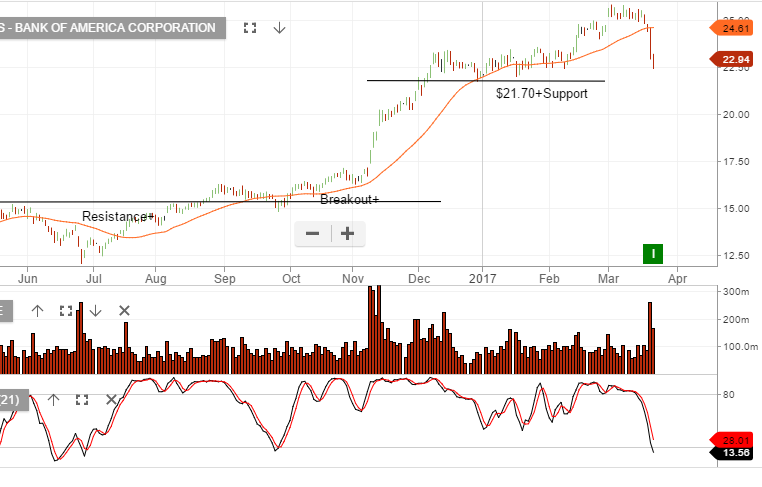
Both the DOW Jones 30 and SP 500 index fell over 1% today during the worst trading session for 2017 for US Blue-Chip stocks.
Banking names led the hefty losses, with the DJ Banking Index trading back below the 50-day moving average.
Dow/SP component Goldman Sachs lost almost $10.00 on the day and is now 10% lower than the March 1st close of $253.00.
A confluence of lower loan growth, political uncertainty and extended valuations pressured the banks, as well as the general market, lower on very high trading volume.
Technically, both the DOW Jones and the SP 500 have posted their first close below the 30-day moving average since November 7th.
The unwinding of the overbought conditions in many of the index components will likely be a process more than an event.
With the banking sector very heavily weighted in the ASX 100, this process will likely pressure Australian names lower, as well.
Investors who are looking to hedge their portfolios or profit from a down move in the ASX can trade either the BetaShare BBOZ or BEAR Exchange Traded Funds.
These are inverse funds which gain value as the ASX index trade lower. Please call for more information.
US Stock Indexes closed lower on Friday as option expiration and continued weakness in the financial sector offset gains in the industrial and utility names.
The Financial index finished the day over 1.5% lower with the major banks stocks: JP Morgan, Goldman Sachs, Citi Group and Bank of America all falling by more than 1% by the New York close.
With the SP 500 index now trading at 22 X earnings on a forward yield of just under 2.5%, the medium-term fundamentals don’t appear to support the high level consolidation at these prices.
Technically, the SP 500 index has not closed below the 30-day moving average in over 4 months.
We now see key price support at 2356.00. A break of this level would likely extend back to the February 13th low of 2310.00.
Chart below of Dow Jones Index and S&P500


Computershare looks expensive.
We generally don’t participate on the buy-side when it comes to options on individual stocks. However, we do buy index options to hedge portfolios or to make profits on short-term corrections.
In the current environment, when some stocks look overvalued, it makes sense to buy put options on a stock specific basis.
Let’s track these over the weeks ahead as a strategy to profit from a pull-back in the share price of CPU.
We buy the $13.75 May Put options for $0.45.

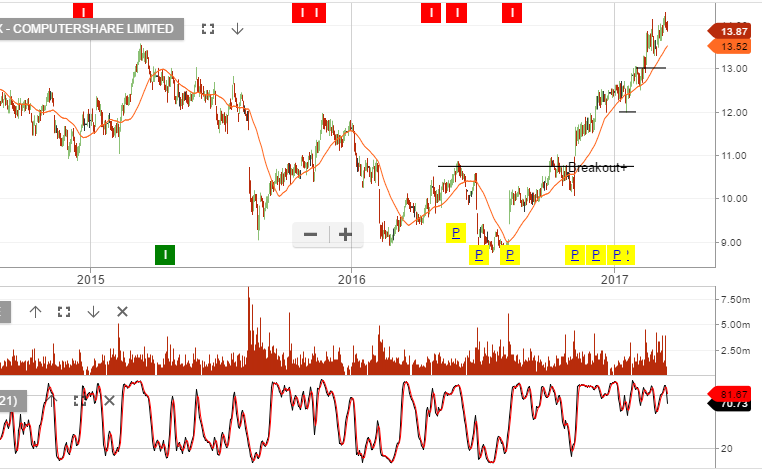
The Chinese government suggests there’ll be no hard landing. China’s financial system is generally stable and there are no systemic risks. Adding, that the government has enough policy tools to handle any risks.
China’s fiscal revenue and expenditure saw faster growth in the first two months of 2017, driven by an improved economy and higher spending on social welfare, official data showed yesterday.
Fiscal revenue rose 14.9% Y/Y to 3.15 trillion yuan (US$456 billion) in January and February, accelerating from 4.5% in 2016, according to data from the Ministry of Finance.
The ministry attributed the revenue pickup to positive trends in the Chinese economy, citing improvement in industrial activity, company profits, foreign trade and resident consumption.
The government is increasing policies to curb property price inflation within major cities and stem broader capital outflows from the Chinese economy. We continue to see these two issues as risks that may yet be underappreciated by the markets.

The Dow Jones had a minor retracement from the 1 March high of 21,169 to close the week out at 20,902. Wednesday in the US will see the Fed Reserve hand down their decision on US rates, with the market now pricing in a 92% chance of a .25% increase.
Interestingly, defensive names such as consumer staples have been some of the best performing stocks, (on a relative basis), when compared to other market sectors over the past month. In many cases, we’re now seeing PE ratios extend to 22x earnings and yields compressing down to 2.2%.
Dow leaders such as Boeing & Goldman Sachs are selling off after their terrific rally and GE, which has under performed lately, showed strength in Friday’s session.
Due to stretched equity valuations, we’re most likely to see further consolidation in the major indices.


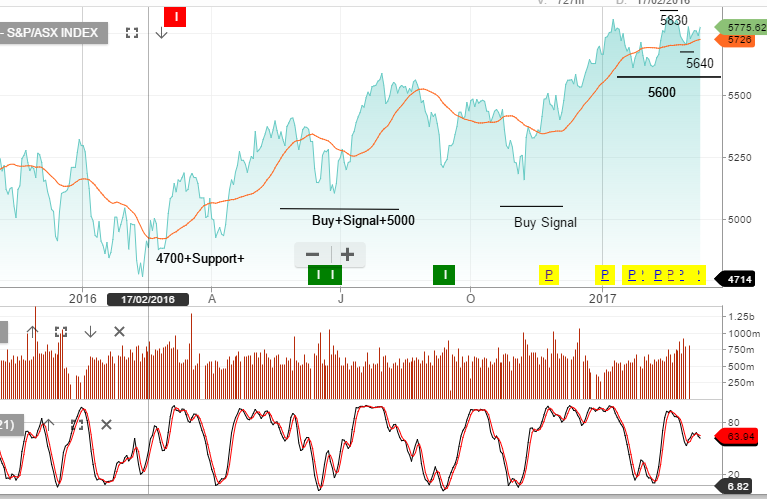
The US Non-Farm Payroll (NFP) report, scheduled for 12:30 am Sydney time tonight, could have a significant impact on global financial markets.
In a speech last Friday, FED Chief Janet Yellen was very clear that steady employment growth and rising inflation were the key indicators guiding US interest rate policy.
Tonight’s report will reflect both the number of new jobs created in the month of February and the pace of wages growth.
Wednesday’s release of the ADP private sector job’s report printed much higher at 298,000 on expectations of 184,000. And while the ADP data is far from a foolproof indicator of the NFP report, it would be a big surprise if the headline jobs number printed much below the 200,000 consensus forecast.
Against this backdrop of an imminent FED rate hike, US 10-yr bond yields have reached a three year high of 2.64%, Gold has dropped below $1200.00, Crude Oil has fallen more than 8.5% this week and Copper has lost more than 6% over the last 10 trading sessions.
It’s likely that a NFP print of 230,000, or more, will be bullish for the US Dollar and negative for Global equity markets.
Or start a free thirty day trial for our full service, which includes our ASX Research.